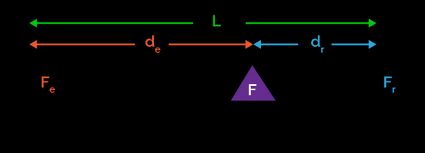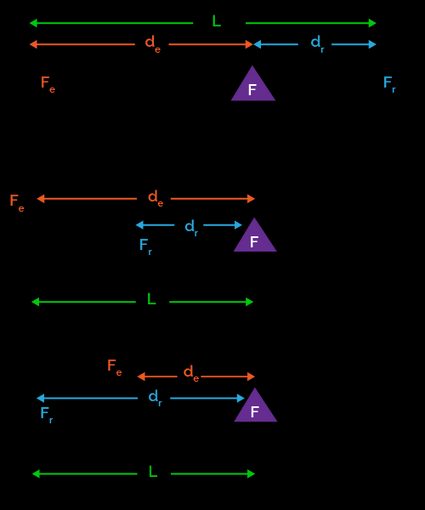Fulcrum Calculator
This fulcrum calculator with help you find the ideal fulcrum point on your lever so that you can lift a load or apply a force with the mechanical advantage you desire!
You've come to the right place if you were wondering how one chooses a lever's fulcrum position on one's lever. In this article, let's discuss the fundamental laws that calculate a lever fulcrum and answer these basic questions:
- What is the fulcrum of a lever?
- How do you calculate mechanical leverage?
- What is the fulcrum equation for the three classes of levers?
- How to find the fulcrum point?
If you're exclusively interested in calculating lever forces, use our lever calculator.
What is the fulcrum of a lever?
A lever is a simple machine made up of a beam or a bar that pivots around a point on itself. This pivot point is called its fulcrum or pivot point, and it usually connects the lever to the ground.
Aside from the beam (or bar) of your lever, there are three main components you need to know:
- Fulcrum is the pivot point around which a lever rotates.
- Resistance is the load we want to lift or apply force through our lever.
- Effort is the force we shall apply to the lever to move it.

Law of the lever and calculating mechanical leverage
The law of the lever states that the forces applied farther away from the fulcrum must be less than the forces applied closer to it. We can summarize this with a balance of moments to obtain:
where:
- - Resisting force (or load);
- - Distance of the resistance from the fulcrum (or the "load arm");
- - Effort force that we apply to lift (or counterbalance) the resistance; and
- - Distance of the effort from the fulcrum (or the "effort arm").
We use this lever equation for calculating lever forces. To understand the moments in a lever, we recommend you read further in our torque calculator.
A lever's mechanical leverage or the mechanical advantage is the ratio of the resisting force to the effort force. By combining with the lever equation we introduced above, we can calculate mechanical leverage as:
Here is the mechanical advantage.
This relation shows that we can lift heavy loads with little effort if the effort arm is longer than the load arm. To quote Archimedes, "Give me a lever long enough and a fulcrum on which to place it, and I shall move the world."
If you wish to learn more about this, use our mechanical advantage calculator.
Types of levers
Before we proceed to the lever fulcrum calculation, we must learn the class of the lever. Based on the location of its three components, we can classify levers as follows:
- Class I lever has the fulcrum between the load and the effort. A see-saw is the first image that should come to mind.
- Class II lever has the resistance between the fulcrum and the effort. Wheelbarrows are an excellent example of this kind.
- Class III lever has the effort between the fulcrum and the load. A pair of tongs and tweezers are great examples to visualize this class.

Fulcrum equation
Say is the length of the lever at hand, and you need to calculate the fulcrum of the lever.
First, consult the previous section to decide which class of lever you have because it determines the type of the fulcrum equation we must use.
- For Class I lever, the length of the lever is:
Substituting this in the lever equation, we get:
We can use this fulcrum formula for calculating lever distances for all class I levers.
- For Class II lever, the length of the lever is:
In other words, the fulcrum and the effort are on the opposite ends of the lever. Substituting this in the lever equation, we get:
Using this fulcrum equation, we can calculate lever distances for all class II levers.
- For Class III levers, the length of the lever is:
In other words, the fulcrum and the load are at the opposite ends of the lever. Substituting this in the lever equation, we get:
This fulcrum equation can calculate all lever distances for all class III levers.
Let's summarize everything we've learned so far in the next section.
How do you find the fulcrum point?
To calculate the fulcrum location of a lever of length L, follow these steps:
- Determine the class of the lever based on the location of the fulcrum, the load Fr, and the effort Fe.
- Calculate the mechanical advantage MA using the equation MA = Fr/Fe.
-
- For a class I lever, calculate the distance dr of the fulcrum from the load using dr = L / (MA + 1).
- For a class II lever, determine the distance dr of the fulcrum from the load using dr = L / MA.
- For a class III lever, the distance dr of the fulcrum from the load is equal to the length of the lever, dr = L.
How to use this lever fulcrum calculator
This fulcrum calculator will help you pinpoint the ideal fulcrum location for your lever, no matter the lever class. It is pretty simple to use:
- Select the appropriate lever class from the
Lever classlist. -
- Enter the correct values for the
Load,Effort, and theLength of the leverfields. This calculator will show you the ideal fulcrum position relative to the load and effort and the mechanical advantage you will achieve. - Alternatively, give the correct values for the
Length of the leverandMechanical advantageyou want to achieve. You will get the best fulcrum position relative to the load and effort.
- Enter the correct values for the
FAQs
Which fulcrum position on a 1m lever can give twice the mechanical advantage?
1/3 m away from the load and 2/3 m away from the effort.
To calculate the fulcrum position that gives a mechanical advantage of MA = 2 with a class I lever of length L = 1 m, follow these simple steps:
- Calculate the distance dr from the load to the fulcrum using dr = L/( MA + 1) = 1/3.
- Determine the distance de from the fulcrum to the effort using de = L - dr = 1 - 1/3 = 2/3.
- Verify your results using our fulcrum calculator.
What type of lever is the human elbow joint?
The human elbow joint is an example of a Class III lever. When we lift loads in our fists, the elbow joint acts as a fulcrum and the bicep muscle exerts the needed force a small distance from the elbow.
How do you calculate the length of the effort arm?
To calculate the length of the effort arm de of a lever to lift a load Fr with an effort Fe, follow these simple steps:
- Determine the mechanical advantage MA using MA = Fr/Fe.
- Measure the length of the load arm dr as the distance between the fulcrum and the load.
- Multiply MA with dr to get the effort arm as de = MA × dr.
